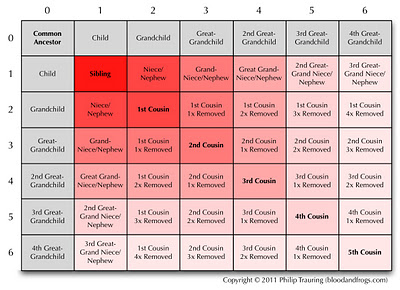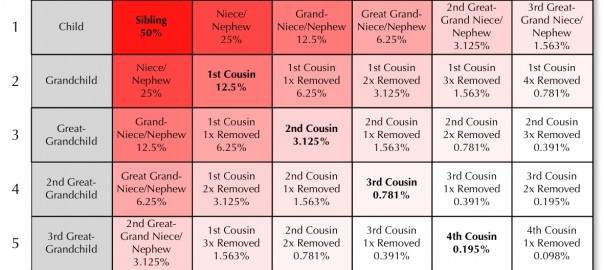In a project I’m working on I have been giving some thought to how we relate to others, but also how we perceive we relate to others. These are not necessarily the same. Certainly it’s possible to be closer socially with cousins that are more distantly related than other cousins, but that’s a choice. What I am thinking about is how we actually perceive we are related to others, and are we right? How would we judge that in any case?
I’m sure many of you are familiar with the traditional ‘cousin calculator’ chart, such the the one below (click to enlarge):
 |
| Traditional Cousin Calculator Chart |
For those of you unfamiliar with how a cousin calculator works, you take two people and determine their common ancestor. You move in one direction (i.e. along the top) from the common ancestor until you reach the relationship of the first person to the common ancestor. You then move in the other direction (i.e. down along the side) until you reach the relationship of the second person to the common ancestor. The box where those two lines merge is the relationship between the two people. For example, if you are the great-grandchild and someone else is the grandchild of a common ancestor, you move along the top to the third column for great-grandchild, and down to the second row for the grandchild, and the box that is in the 3rd column and the second row is 1st Cousin, Once Removed.
If you take a close look, you’ll notice I’ve color-coded the chart how I think we normally perceive relationships. Essentially, our sibling and parents are one degree away, our nieces/nephews and 1st cousins are two degrees away, and so forth. A second cousin is generally perceived as one degree further away from us than a first cousin. A first cousin, once removed is, at least to me, in the same category as a second cousin, and that’s what this chart shows.
Now how can we actually determine how closely we’re related? One simple method is by how much DNA we share. If we add in the percentage of DNA present between any two relatives to the chart it looks a bit different (click to enlarge):
 |
| DNA Cousin Calculator Chart |
Note in the above chart that I’ve changed the color coding to match the percentages of shared DNA. The colors no long take a box shape around the common ancestor, but instead move out in the straight line. What we can see by looking at the numbers is that actually the degree of relationship is moving twice as fast as we perceived before. From a first cousin to a second cousin, the amount of shared DNA is one quarter, not one half. We perceive the second cousin as being twice as distant a relative as a first cousin, but from the perspective of DNA, they are actually four times as distant!
I know one of my 5th cousins, and we share just 0.049% DNA. That’s a half of a tenth of a percent. Not very much. Anyways, this was just an attempt to create some kind of objective view of family relationships. Of course, nothing having to do with family is really objective, right?

A question, how come you only share 50% of your DNA with a sibling? How do you arrive at that figure?
You inherit half of your DNA from you mother and half from your father, so theoretically you could match 100% with a sibling (if you inherited the exact same DNA like identical twins), however, the DNA you inherit from your parents is not the same DNA your sibling inherits (it is random) and thus generally you will average out at matching 50% with your siblings. These numbers are not exact, and as you move down generations you may lose all the DNA of a granparent for example, and have no common DNA with a cousin on that side. This is just statistics.
For more information, check out the ISOGG web site:
http://www.isogg.org/wiki/Autosomal_DNA_statistics
You can also check out the infromation on FamilyTreeDNA (http://www.familytreedna.com/faq/answers.aspx?id=17#624) and 23andMe (http://spittoon.23andme.com/2010/10/15/ancestry-at-23andme-sheridans-got-relatives/) web sites.
Hi Philip, very interesting. I’m a (non-identical female) twin. How much DNA do you think I share with my twin andhow much do I share with my little nephew? Does the twin thing make any difference?
Naomi
Naomi,
In theory fraternal twins would have the same 50% shared DNA on average. Thus your nephew and you would share 25% of the same DNA, with your being a twin not making any difference. Again, these are just statistical averages.
If you were identical twins then theoretically your nephew would share 50% of your DNA.
In the end, the only way to get exact numbers is to get your DNA tested, along with yur sister and nephew for comparison.
Hi Philip, I concede your point about counting siblings at 50% because that is the average mix of the same genes you’ll get. But I disagree about the cousins.
My first cousins and I draw from the same gene pool for half of our total genes. Same grandparents. This means we’d, on average, share 25% of our genes.
You’re doing a double halving, assuming that because our parents, who are siblings, are 50% the same genes, we need to reduce from there. But we don’t. We are pulling from the same gene pool, our grandparents. Statistically, we should work back to the shared ancestors and then do a single halving.
So, for example, I share 1/4 of my ancestors with my second cousins so I would share 12.5% of their genes. You are doing a double halving (a quartering) for each generation, so you have second cousins at just over 3%.
Then of course there is the extra chance of matched genes because of shared ethnicity, marriage between moderate to distant relatives (very common with any ancestor from a small town, especially one without tons of Jews), etc. I’m also only counting the genes that vary among humans, not the vast majority of genes that make us human in the first place.
Cyndi,
Think of it this way. You have two siblings, and they share 50% DNA. The reason they share 50% and not 100% is because of the randomness of DNA inheritance. Thus, when each of the siblings has their own children, those children also randomly inherit 50% from each parent. The reason it’s 12.5% is because there is 50% random selection from both cousins, and they’re not selecting the same DNA. Thus statistically, the same reason that you share only 50% of your DNA with your siblings (instead of 100%), is the same reason you share only 12.5% of your DNA with your 1st cousins (instead of 25%).
These numbers are born out through genetic databases by 23andMe, FamilyTreeDNA and others.
Philip
Cyndi,
Another way to look at it is that two first-cousins who share a pair of grandparents would each be expected to share 25% of their DNA with those grandparents, but obviously not the same 25% (since it comes from children that each randomly inherited from their parents).
Thus when inheriting DNA from their parents, those grandchildren are selecting from only 25% of the same DNA. It’s still 50% of the DNA of that pair of grandparents that they are inheriting from, but it’s not the same 50%, thus on average it’s really 25%.
Since they inherit from both parents, they thus only inherit 12.5% common DNA.
Philip,
I understand the math, I just disagree that you would need to halve the numbers twice for each generation.